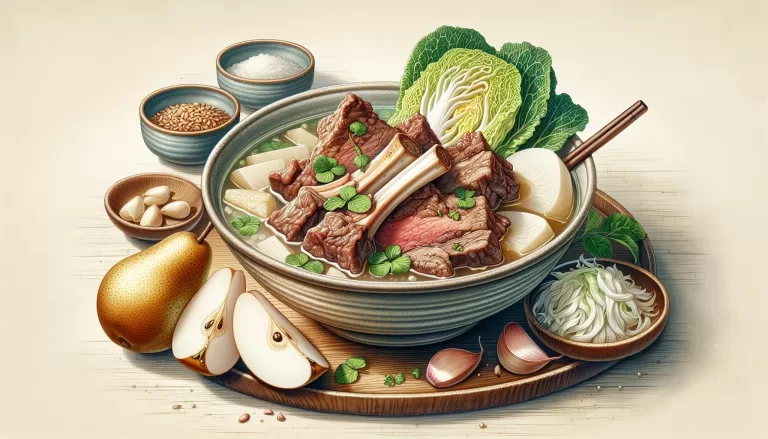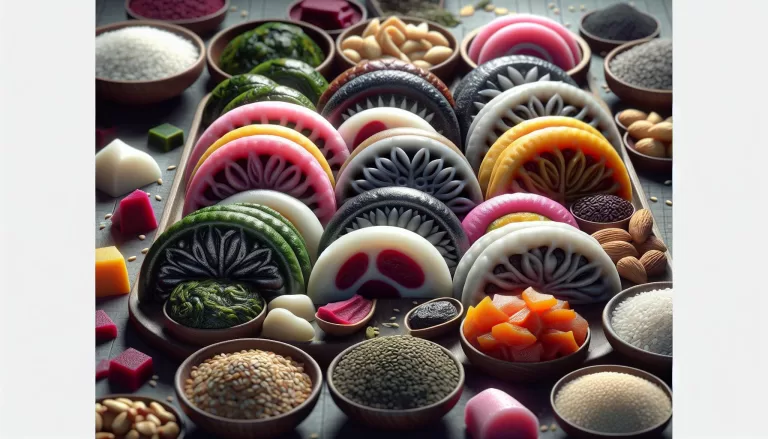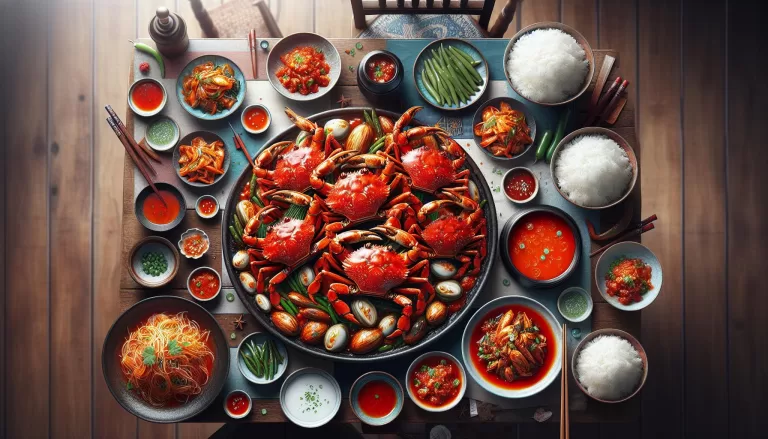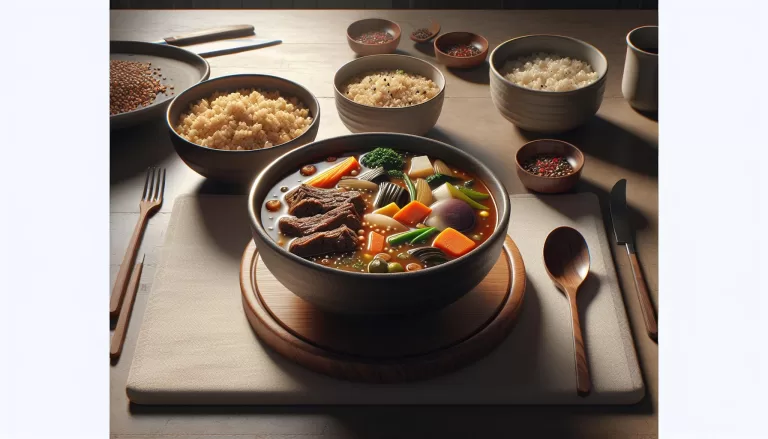Easy Homemade Haemul Sundubu Jjigae Seafood Soft Tofu Recipe – A Nutritious Korean Delight
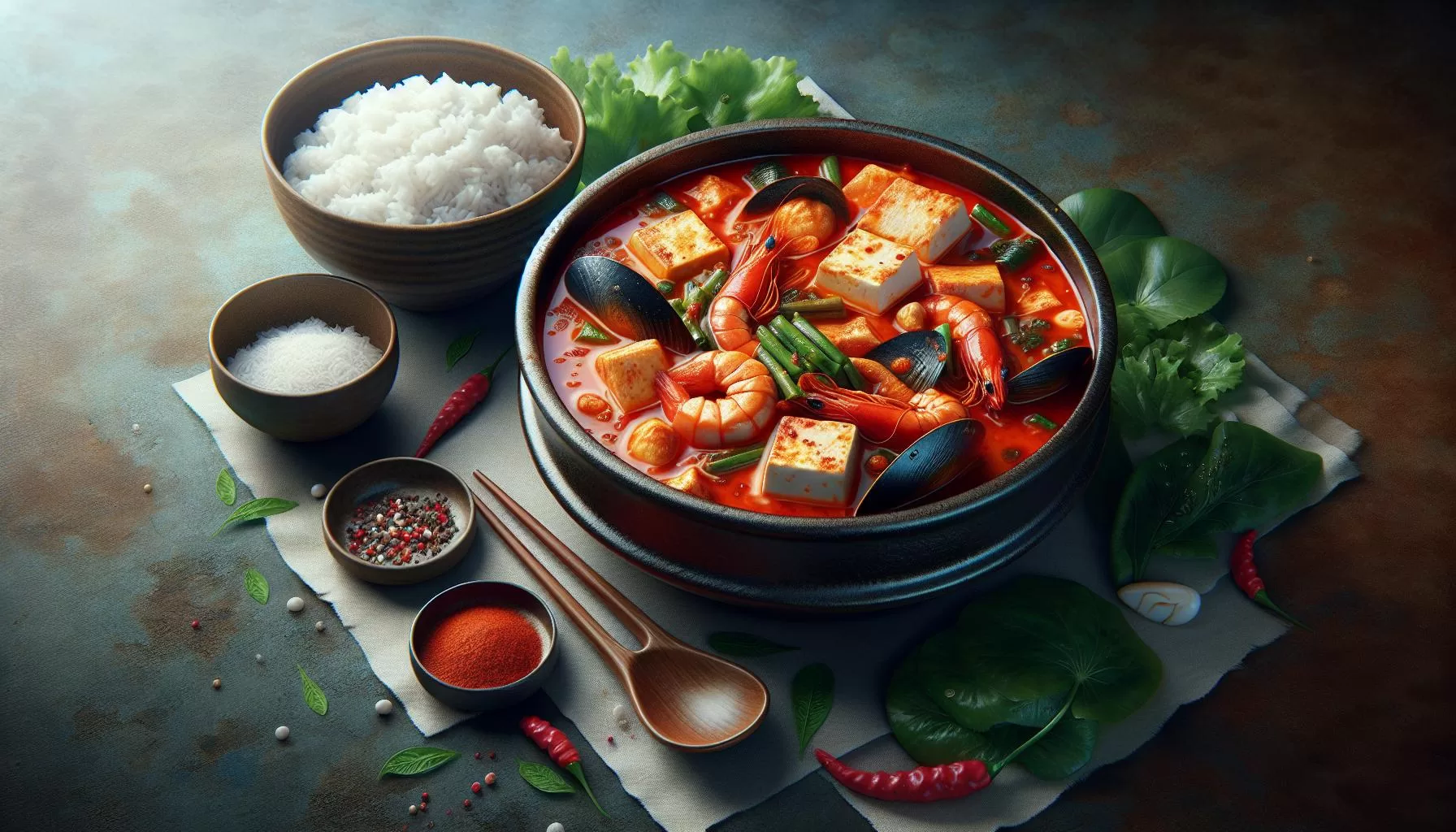
Ingredients for Homemade Haemul Sundubu Jjigae
For a top-tier Homemade Haemul Sundubu Jjigae, you’ll need certain key ingredients. Let’s dive into what makes this dish sensational.
You’ll need 300 grams of soft tofu. This forms the base of your stew, giving it its characteristic silky texture. Anyone with an interest in alternative options could consider using silken tofu for an even smoother mouthfeel.
Next up: 150 grams of mixed seafood. This could include prawns, mussels, clams, or squid. Don’t be afraid to explore, every variation will add a unique flavor twist to your stew.
You can’t forget the stock, which is vital for achieving that intense, rich flavor. 10 dried anchovies, 1 piece of kelp (around 8 cm), and 5 cups of water should do the trick.
Going further, arm yourself with one medium-sized onion, 2 stalks of spring onions, 2 garlic cloves, and 1 chili pepper. These ingredients will bring in that required sharpness and leave an unforgettable aromatic trace.
For that striking red color and unmistakable spicy kick, 1.5 tablespoons of hot pepper flakes are in order.
| Ingredient | Quantity/Measurement |
|---|---|
| Soft Tofu | 300 grams |
| Mixed Seafood | 150 grams |
| Dried Anchovies | 10 |
| Kelp | 1 piece (8cm) |
| Water | 5 cups |
| Onion | 1 medium size |
| Spring Onions | 2 stalks |
| Garlic Cloves | 2 |
| Chili Pepper | 1 |
| Hot Pepper Flakes | 1.5 tablespoons |
For the health enthusiasts among you, rest assured. This dish is full of beneficial nutrients. Soft tofu is rich in protein and low in calories, contributing to a balanced diet. The seafood, on the other hand, provides you with omega-3 fatty acids, vitamins and minerals. A burst of flavors, yes, but also a well-rounded, nutritious meal all in one pot.
Step-by-Step Instructions

Let’s dive right into turning those ingredients into a savory bowl of haemul sundubu jjigae. Properly combining and managing these components can somewhat be an art, so the following steps aim to guide you in making a creation that stands out.
Step 1: Start by making the stock. Combine 10 dried anchovies and a 6-inch strip of dried kelp in a pot with 4 cups of water. Bring this mixture to a simmer, keeping it covered to retain flavor. After about 20 minutes, discard the anchovies and kelp, reserving the stock. Your soup base is now ready.
Step 2: Quick tip – Dice the aromatic elements beforehand. This includes one small onion, four peeled garlic cloves, and one red chili pepper. These add to the taste and visual appeal of your dish.
Step 3: In a large pan, add your mixed seafood and heat it over medium heat. Use about 2 cups of seafood for a truly ocean-esque experience. Kitchen secret – Try using a mix of shrimp, scallops, and calamari to give your stew variety.
Step 4: Add the diced aromatics to the pan, cooking them until they release their fragrance. Then add the stock, and bring to a boil.
Step 5: Now, it’s time for the star of the dish – the soft tofu. Add one 16-ounce block of soft tofu to the pot. Break it gently into the broth. Don’t rush this process to make sure all of the tofu absorbs the robust flavors of the simmering pot.
Step 6: Season the stew with one tablespoon of Korean chili powder and soy sauce to taste. Let it simmer for 10 more minutes.
| Step | Ingredient and Quantity |
|---|---|
| 1 | Dried Anchovies (10), Dried Kelp (6-inch strip), Water (4 cups) |
| 2 | Onion (1 small), Garlic Cloves (4), Red Chili Pepper (1) |
| 3 | Mixed Seafood (2 cups) |
| 4 | — |
| 5 | Soft Tofu (16-ounce block) |
| 6 | Korean Chili Powder (1 tablespoon), Soy Sauce (to taste) |
Tips for Making the Perfect Seafood Soft Tofu Stew

When cooking Homemade Haemul Sundubu Jjigae, there’s a lot more that comes into play than your kitchen equipment and ingredients. Your cooking technique is also crucial to the outcome of the dish. Adhere to these simple tips to make your seafood soft tofu stew stand out.
Careful selection of seafood
Choosing the right kind of seafood can make or break your dish. Fresh, high-quality seafood brings out the best flavors. Consider a variety of seafood like clams, prawns, and squid to add diverse flavors and textures.
Flavor your tofu
Don’t shy away from seasoning your tofu. A common misconception is that soft tofu is bland. Actually, it’s quite the chameleon, quickly absorbing the flavors from the stew. Add the tofu right after cooking your seafood. This allows the tofu to soak up the seafood’s flavor, further enriching your stew.
Do not overcook
Seafood and soft tofu both have delicate textures. Overcooking can easily result in rubbery seafood and crumbling tofu. A tip to avoid this is to add the tofu and seafood last after your spicy broth is ready. Then, you just need a few minutes to gently simmer the stew.
Adjust to your taste
The beauty of Haemul Sundubu Jjigae lies in its versatility. While there’s a basic recipe, feel free to tweak it according to your preferences. If you want your stew spicier, add more Korean chili powder. On a sodium-restricted diet? Try using low-sodium soy sauce.
Through these tips and tricks, you’ll not just be following a recipe. Instead, you’ll be adapting it to meet your unique palate, allowing for the creation of a Haemul Sundubu Jjigae that’s truly yours. With each spoonful, you’ll savour the rich seafood broth, soft tofu and a potpourri of spices. Now, who’s ready to take their cooking to the next level?
Health Benefits of Haemul Sundubu Jjigae

Diving deeper into the culinary rewards, Haemul Sundubu Jjigae isn’t just a sensory delight but also packs a punch of health benefits. If you’re health-conscious, this stew’s got your back.
Centred around seafood and tofu, this dish is a protein powerhouse, essential for muscle growth, tissue repair, and vitality. Seafood, being high in Omega-3 fatty acids, boosts heart health, improves brain function, and nourishes your skin. It’s got vitamin B12 too, promoting nerve health and keeping your body’s nerve and blood cells healthy.
Tofu on the other side, low in calories yet high in protein, is a great choice for both weight-watchers and fitness enthusiasts. It’s a fantastic source of bone-beneficial nutrients – Calcium and Vitamin D. Tofu’s also rich in isoflavones, plant-based compounds credited with lowering risk of osteoporosis and certain types of cancer.
Besides stars of the dish, the broth base features a lineup of nutritious ingredients. For instance, kelp – it’s an underwater powerhouse of nutrients, high in antioxidants, aiding in weight loss, supporting thyroid health, improving heart health, and reducing inflammation.
As always, there’s room for added health benefits with customization. Swapping regular soy sauce with low-sodium version can reduce the overall sodium content. Adding more veggies to the dish enhances the dietary fiber content and amplifies antioxidant input.
So, as you swoon over the creamy tofu, relish the succulent seafood, and relish the savory broth, know you’re doing your health a favor too. Beyond the tempting taste, Haemul Sundubu Jjigae offers a wholesome package promoting health and wellness. Remember, eating should be about feeling good, and this dish brings you just that – a heart-warming, nourishing experience your body will thank you for.
Remember to adjust the seasoning as per your health goals and never overcook to maintain the delicacy of ingredients and the integrity of their nutrients. You’re not just creating a delicious meal, you’re also crafting a healthier lifestyle, one dish at a time. Enjoy your cooking journey and let Haemul Sundubu Jjigae nourish your soul, palate, and well-being.
Serving and Enjoying Your Delicious Creation

Once your Haemul Sundubu Jjigae is ready, serve it straight from the stove and enjoy its delightful flavors. However, the way you present and consume this dish can significantly enhance its taste and nutritional value.
For starters, you need to serve this stew in traditional Korean earthenware bowls known as “tteokbaegi“. These bowls hold heat exceptionally well, keeping the stew bubbling hot throughout your meal. But taking the time to plate your dish properly not only makes your food appetizing to look at but also allows for an improved sensory experience.
Use fresh leafy green like spinach or rocket for presenting the stew. This adds a lively contrast to the dish, enhances its visual appeal and even provides an extra nutritional boost.
On the side, try adding a bowl of steamed short-grain rice. It pairs well with the stew, soaking up the broth and providing a hearty, fulfilling meal. The rice forms a complex carbohydrate, which breaks down slowly, giving you a sustained energy boost.
Of course, the nutritional value of your meal is crucial. A single serving of your Homemade Haemul Sundubu Jjigae could contain approximately 275 calories, 15 grams of protein, and 13 grams of fat. Here is the nutritional breakdown in detail:
| Nutrient | Amount per serving |
|---|---|
| Calories | 275 Cal |
| Carbohydrates | 11g |
| Protein | 15g |
| Fat | 13g |
Adding more fresh vegetables and using lean seafood could diversify these stats further. They can aid you in accomplishing your dietary goals whether you’re trying to increase your protein intake, reduce carbs, or add more nutrients. Besides, trying new ingredients might give your stew a unique taste, surprising your palate with every bite.
Conclusion
Now that you’ve learned how to make homemade Haemul Sundubu Jjigae, it’s time to put your culinary skills to the test. Remember, presentation is key – serve your stew in traditional Korean earthenware bowls for that authentic touch. Pairing it with fresh greens and steamed rice not only complements the dish but also makes for a satisfying meal. Don’t forget, this recipe is flexible. Feel free to add more veggies or lean seafood to meet your nutritional goals. Experimentation could lead to a whole new flavor experience. So, dive in, enjoy the process, and most importantly, savor every spoonful of your homemade Haemul Sundubu Jjigae.

